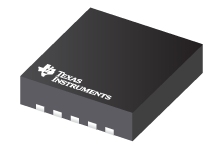Datasheet Texas Instruments TPS61200DRCTG4
| Manufacturer | Texas Instruments |
| Series | TPS61200 |
| Part Number | TPS61200DRCTG4 |

0.3V Input Voltage Boost Converter with 1.3A Switches and 'Down Mode' in 3x3 QFN 10-VSON -40 to 85
Datasheets
TPS6120x Low Input Voltage Synchronous Boost Converter With 1.3-A Switches datasheet
PDF, 1.4 Mb, Revision: E, File published: Dec 24, 2014
Extract from the document
Prices
Status
| Lifecycle Status | Active (Recommended for new designs) |
| Manufacture's Sample Availability | Yes |
Packaging
| Pin | 10 |
| Package Type | DRC |
| Industry STD Term | VSON |
| JEDEC Code | S-PDSO-N |
| Package QTY | 250 |
| Carrier | SMALL T&R |
| Device Marking | BRR |
| Width (mm) | 3 |
| Length (mm) | 3 |
| Thickness (mm) | .9 |
| Pitch (mm) | .5 |
| Max Height (mm) | 1 |
| Mechanical Data | Download |
Parametrics
| Duty Cycle(Max) | 95 % |
| Iq(Typ) | 0.05 mA |
| Operating Temperature Range | -40 to 85 C |
| Package Group | VSON |
| Rating | Catalog |
| Regulated Outputs | 1 |
| Special Features | Enable,Light Load Efficiency,Load Disconnect,Power Good,UVLO Adjustable |
| Switch Current Limit(Min) | 1.2 A |
| Switch Current Limit(Typ) | 1.35 A |
| Switching Frequency(Max) | 1650 kHz |
| Switching Frequency(Min) | 1250 kHz |
| Type | Converter |
| Vin(Max) | 5.5 V |
| Vin(Min) | 0.3 V |
| Vout(Max) | 5.5 V |
| Vout(Min) | 1.8 V |
Eco Plan
| RoHS | Compliant |
Design Kits & Evaluation Modules
- Evaluation Modules & Boards: TPS61200EVM-179
TPS61200EVM-179 Evaluation Module
Lifecycle Status: Active (Recommended for new designs)
Application Notes
- Using TPS61200 as WLED DriverPDF, 159 Kb, File published: Sep 21, 2009
This application report explains how to build a white LED driver circuit using the TPS61200 Boost Converter from Texas Instruments. It also explains an analog dimming scheme for the LED drivers. - Low Voltage Reverse Battery Protection Circuit Using TPS61200 Boost ConverterPDF, 230 Kb, File published: Feb 15, 2009
This application report describes how to implement a reverse-battery-protection feature using the TPS61200 boost converter in applications powered from a single alkaline, nickel-cadmium (NiCd), or nickel-metal hydride (NiMH) cell. - Automated Frequency Response AnalyzerPDF, 939 Kb, File published: Oct 9, 2013
This application report discusses a new method of doing stability Analysis testing by using basic labequipment, while not requiring any specific instruments. - Supplying TPS61200 With a Single Solar Cell (Rev. B)PDF, 129 Kb, Revision: B, File published: Sep 6, 2011
This application report explains how to use the TPS61200 in combination with a single solar cell to charge a battery or storage device. A characteristic of solar cells is the internal resistance that can vary from less than 10 Ω up to more than 100 Ω. Therefore it is important to control the load placed on the solar cell to ensure a reliable start-up of the application. This report describes an a - Five Steps to a Good PCB Layout of the Boost ConverterPDF, 701 Kb, File published: May 3, 2016
- Minimizing Ringing at the Switch Node of a Boost ConverterPDF, 201 Kb, File published: Sep 15, 2006
The application report explains how to use proper board layout and/or a snubber to reduce high-frequency ringing at the switch node of a boost converter. - Design considerations for a resistive feedback divider in a DC/DC converterPDF, 393 Kb, File published: Apr 26, 2012
- Basic Calculation of a Boost Converter's Power Stage (Rev. C)PDF, 186 Kb, Revision: C, File published: Jan 8, 2014
This application note gives the equations to calculate the power stage of a boost converter built with an IC with integrated switch and operating in continuous conduction mode. It is not intended to give details on the functionality of a boost converter (see Reference 1) or how to compensate a converter. See the references at the end of this document if more detail is needed. - Optimizing Transient Response of Internally Compensated DC-DC Converters (Rev. A)PDF, 1.1 Mb, Revision: A, File published: May 11, 2015
- Extending the Soft Start Time Without a Soft Start Pin (Rev. B)PDF, 387 Kb, Revision: B, File published: Jun 15, 2017
- QFN and SON PCB Attachment (Rev. B)PDF, 821 Kb, Revision: B, File published: Aug 24, 2018
- IQ: What it is what it isn’t and how to use itPDF, 198 Kb, File published: Jun 17, 2011
- Performing Accurate PFM Mode Efficiency Measurements (Rev. A)PDF, 418 Kb, Revision: A, File published: Dec 11, 2018
When performing measurements on DC-DC converters using pulse frequency modulation(PFM)or any power save mode proper care must be taken to ensure that the measurements are accurate. An accurate PFM mode efficiency measurement is critical for systems which require high efficiency at low loads such as in smart home systems tablets wearables and metering.
Model Line
Series: TPS61200 (4)
- TPS61200DRCR TPS61200DRCRG4 TPS61200DRCT TPS61200DRCTG4
Manufacturer's Classification
- Semiconductors > Power Management > Non-isolated DC/DC Switching Regulator > Step-Up (Boost) > Boost Converter (Integrated Switch)
